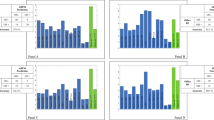Abstract
Non-invasive ambulatory recordings of blood pressure and heart rate were performed using a Spacelabs device during day and night periods in patients with Parkinson's disease with (n = 19) or without orthostatic hypotension (n = 19). In patients with orthostatic hypotension, the average systolic and diastolic blood pressure during the night (137 ± 5/80 ± 3 mmHg) was higher (p < 0.05) than during the day period (121 ± 3/76 ± 2 mmHg). In patients without orthostatic hypotension, a decrease in blood pressure was recorded during the nocturnal period. In patients with orthostatic hypotension, the blood pressure variability was higher (p < 0.05) during the day (systolic: 14.6 ± 1.3%; diastolic: 16.5 ± 1.0%) than during the night (systolic: 9.1 ± 0.8%; diastolic: 10.8 ± 1.1%). The blood pressure load (percentage of values above 140/90 mmHg) during the night was significantly higher than during the day for both systolic (41.2 ± 8.1 vs. 19.6 ± 4.7%) and diastolic blood pressure (24.9 ± 6.9 vs. 16.3 ± 4.9%). There was a decrease in heart rate in both groups during the night. A fall of 25 mmHg or more in systolic blood pressure after meals occurred in ten patients with orthostatic hypotension and in one patient without orthostatic hypotension. These results indicate that orthostatic hypotension in Parkinson's disease is associated with specific modifications of ambulatory blood pressure including loss of circadian rhythm of blood pressure, increased diurnal blood pressure variability and post-prandial hypotension.
Similar content being viewed by others
References
Korczyn AD. Autonomic nervous system dysfunction in Parkinson's disease. In: Calne DB, ed.Parkinsonism and Aging. New York: Raven Press, 1989; 211–219.
Senard JM, Valet P, Durrieu G, Berlan M, Tran MA, Montastruc JL, Rascol A, Montastruc P. Adrenergic supersensitivity in Parkinsonians with orthostatic hypotension.Eur J Clin Invest 1990;90: 613–615.
Pickering TG. Strategies for the evaluation and treatment of hypertension and some implications of blood pressure variability.Circulation 1987;76: 177–182.
Horau MJ. Role of ambulatory blood pressure recording in the diagnosis, prognosis and management of hypertension.Clin Exp Hypertens 1985;8: 205–216.
Weber MA. Automated blood pressure monitoring for the assessment of antihypertensive treatment.Am J Cardiol 1988;62: 97–101.
Maillon JM, Debru JL, De Gaudemaris R, Dimitriou R, Perdrix A, Cau G. Mesure ambulatoire de la pression artérielle: intérét diagnostique, pronostique, et thérapeutique.Presse Med 1985;14: 151–155.
Hilsted J, Galbo H, Christensen NJ. Cardiovascular, hormonal and metabolic responses to graduated exercise in juvenile diabetics with and without autonomic neuropathy.Acta Pediatr Scand 1980;883: 95–100.
Rubler S, Dennis A, Bruzzone CL. Blood pressure and heart rate responses during 24 hour ambulatory monitoring and exercise in men with diabetes mellitus.Am J Cardiol 1985;55: 801–806.
Chamontin B, Barbe P, Begasse F, Ghisolfi A, Amar J, Louvet JP, Salvador M. Pression artérielle ambulatoire au cours de l'hypertension artérielle avec dysautonomie.Arch Mal Coeur 1990;83: 1103–1106.
Hoehn NH, Yahr MD. Parkinsonism: onset, progression and mortality.Neurology 1967;17: 427–442.
Micieli G, Martignoli E, Cavallini A, Sandrini G, Nappi G. Post-prandial and orthostatic hypotension in Parkinson's disease.Neurology 1987;37: 386–393.
Durrieu G, Senard JM, Tran MA, Rascol A, Montastruc JL. Effects of levodopa and bromocriptine on blood pressure and plasma catecholamines in Parkinsonians.Clin Neuropharmacol 1991;14: 84–90.
Mancia G, Pavati G, Pomidossi G, Di-Ricizo M. Validity and usefulness of non-invasive ambulatory blood pressure monitoring.J Hypertens 1985;3 (suppl): 5–11.
Zacchariah PK, Sheps SG, Ifstrup DM, Long CR, Benley KR, Wiltgen CM, Carlson CA. Blood pressure load—a better determinant of hypertension.Mayo Clin Proc 1988;63: 1085–1091.
Seyer-Hansen K. Post-prandial hypotension.Br Med J 1977;2: 1262.
Raimbach SJ, Cortelli P, Kooner JS, Bannister R, Bloom SR, Mathias CJ. Prevention of glucose-induced hypotension by the somatostatin analogue (SMS 201–995) in chronic autonomic failure: haemodynamic and hormonal changes.Clin Sci 1989;77: 623–628.
Armstrong E, Mathias CJ. The effects of the somatostatin analogue, octreotide, on postural hypotension before and after food ingestion in primary autonomic failure.Clin Auton Res 1991;1: 135–140.
Frankel JP, Kempster PA, Bovingdon M, Webster R, Lees AJ. The effects of oral protein on the absorption of intraduodenal levodopa and motor performance.J Neurol Neurosurg Psych 1989;52: 1063–1067.
Author information
Authors and Affiliations
Rights and permissions
About this article
Cite this article
Senard, JM., Chamontin, B., Rascol, A. et al. Ambulatory blood pressure in patients with Parkinson's disease without and with orthostatic hypotension. Clinical Autonomic Research 2, 99–104 (1992). https://doi.org/10.1007/BF01819664
Received:
Revised:
Accepted:
Issue Date:
DOI: https://doi.org/10.1007/BF01819664




